Thu, Mar 30, 2006 11:00 pm
ClamWin Virus Defintions Not Updating
If you try to update the virus defintions for ClamWin by selecting
"Download Virus Database Update" and then see "Completed" immediately
without new definitions being downloaded, the problem may be due
to an incompatibility with the cygwin1.dll required by ClamWin and
the cygwin1.dll file in use by some other application on the system,
such as
OpenSSH for Windows.
See
Incompatibility between OpenSSH for Windows and ClamWin for instructions
on how to fix the problem.
You can determine which processes have the cygwin1.dll
DLL loaded with the
tasklist command on a Windows XP system.
C:\Program Files\ClamWin\bin>tasklist /m /fi "modules eq cygwin1.dll"
Image Name PID Modules
========================= ====== =============================================
sshd.exe 5276 ntdll.dll, kernel32.dll,
cygcrypto-0.9.7.dll, cygwin1.dll,
ADVAPI32.DLL, RPCRT4.dll, cygz.dll,
ws2_32.dll, msvcrt.dll, WS2HELP.dll,
mswsock.dll, hnetcfg.dll, GDI32.dll,
USER32.dll, wshtcpip.dll, wsock32.dll,
DNSAPI.dll, winrnr.dll, WLDAP32.dll,
Secur32.dll, mpr.dll, uxtheme.dll
switch.exe 2336 ntdll.dll, kernel32.dll, cygwin1.dll,
ADVAPI32.DLL, RPCRT4.dll, Apphelp.dll,
user32.dll, GDI32.dll
sh.exe 1192 ntdll.dll, kernel32.dll, cygwin1.dll,
ADVAPI32.DLL, RPCRT4.dll, user32.dll,
GDI32.dll
sh.exe 3836 ntdll.dll, kernel32.dll, cygwin1.dll,
ADVAPI32.DLL, RPCRT4.dll, Apphelp.dll,
VERSION.dll, user32.dll, GDI32.dll
[/security/antivirus/clamav]
permanent link
Wed, Mar 29, 2006 12:39 am
Installation of CDisplay with wpkg
I wanted to configure
wpkg for a silent
install of
CDisplay, which is a free comic reader program. It allows images of pages
that have been scanned from comics and stored in an ace, zip, rar, or tar file
to be viewed by loading JPEG, PNG and static GIF images which are automatically
ordered and presented for viewing one at a time or two at a time allowing one
to read the electronic version in a manner similar to the paper copy.
I needed to have the program installed on a couple of PCs in my
household and wanted to be able to install it on a system along with
other software we commonly use by running wpkg.js from the server.
My wife has scanned a good portion of her extensive comics collection
and wants to be able to view them from any PC in the house.
I looked at the setup.exe file with
FileAlyzer.
When I listed strings in the file, I saw "Inno", so I
knew it used Inno Setup
an open source installer.
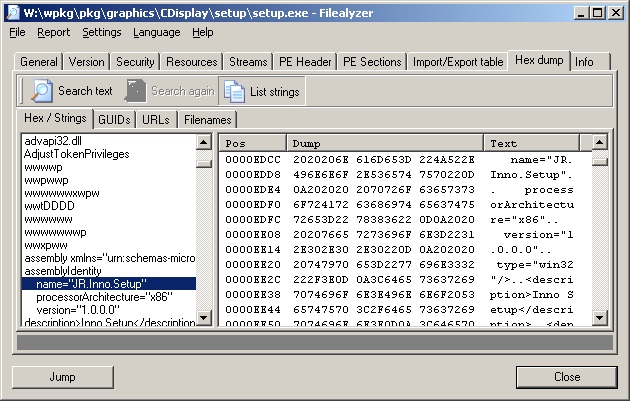
That installer allows you to perform a silent install
with the "/silent" or "/verysilent" options.
/SILENT, /VERYSILENT
Instructs Setup to be silent or very silent. When Setup is silent the
wizard and the background window are not displayed but the installation
progress window is. When a setup is very silent this installation progress
window is not displayed. Everything else is normal so for example error
messages during installation are displayed and the startup prompt is
(if you haven't disabled it with DisableStartupPrompt or the '/SP-'
command line option.
If you don't specify the "/SP-", option a window will appear with the
question "This will install CDisplay. Do you wish to continue?", which
will require a "yes" or "no" response.
You can specify the installation directory with the
"/Dir=dir" option. So I put the following lines in the
wpkg packages.xml file to install the software in
"C:\Program Files\comics\CDisplay". If you specify a directory in which
to install the program, rather than taking the default one, you do not need
to ensure that higher level directories exist first. E.g., in the example
below, the directory "c:\program files\comics" does not have to already exist,
if %PROGRAMFILES% corresponds to "C:\Program Files". Both the "Comics"
and "CDisplay" directory beneath it will be created.
The package section below, which should be placed in packages.xml,
assumes version 1.8 of CDisplay is being used.
<package
id="CDisplay"
name="CDisplay"
revision="1"
reboot="false"
priority="1">
<check type="uninstall" condition="exists" path="CDisplay 1.8" />
<install cmd='\\server\wpkg\pkg\comics\CDisplay\setup.exe
/VerySilent /SP- /Dir="%PROGRAMFILES%\Comics\CDisplay"'>
<exit code="0" />
</install>
<remove cmd='"%PROGRAMFILES%\Comics\CDisplay\unins000.exe"' />
The remove command above will uninstall the software, but a prompt
will appear on the system asking for confirmation. When I tried
the "/silent" or "/verysilent" options for the unins000.exe command,
the uninstall failed. It was successful when I did not use either of those
options.
References:
-
Unattended, A Windows deployment system: Unattended/Silent Installation
Switches for Windows Apps
-
Inno Setup Command Line Parameters
[/os/windows/software/wpkg]
permanent link
Wed, Mar 22, 2006 11:56 pm
Compressing ClientApps Folder on an SBS 2003 Server
I found the free space on the C: drive on a Windows Small Business
Server (SBS) 2003 system was almost depleted. By compressing the
ClientApps folder I was able to gain another 300
MB of space.
I found the C:\ClientApps folder was taking about 1 GB of disk space,
so I chose to compress it, which you can do by the following procedure.
- Right-click on "ClientApps" folder.
- Select "Properties".
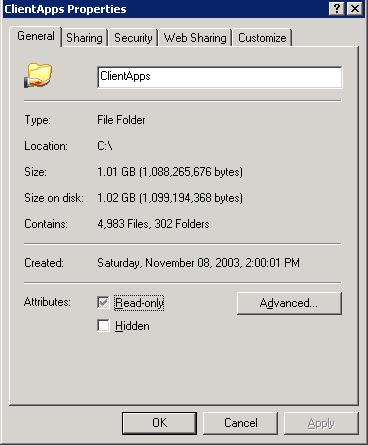
- Click on the "Advanced" button and select "Compress contents to
save disk space.
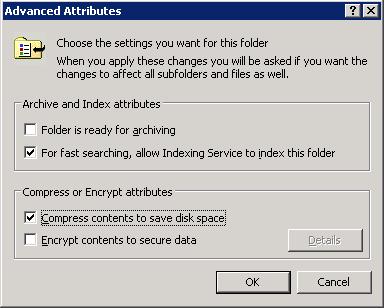
- Click on "OK".
- Click on "OK" again to close the "ClientApps Properties" window.
- When the "Confirm Attribute Changes" window appears, leave "Apply
changes to this folder, subfolders and files checked and click on "OK".
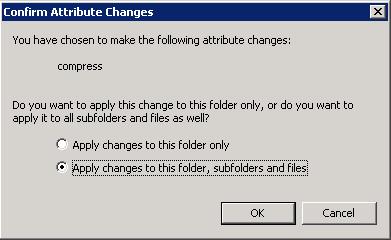
When I started the compression, Windows estimated the process would take
23 minutes, but it actually only took a few minutes. It gave me about 300 MB
more of disk space. When I right-clicked on the folder afterwards and selected
"Properties", the file size was still listed as about 1 GB, but the size on
disk was only 751 MB.
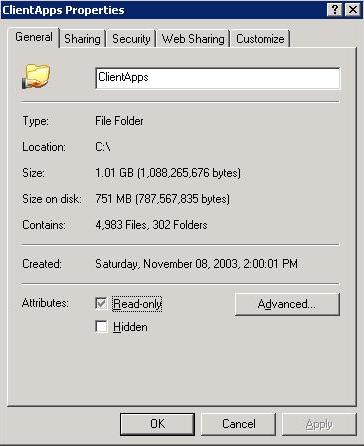
For other steps for freeing disk space, see
Freeing Disk Space.
[/os/windows/server2003/free-disk-space-sbs2003]
permanent link
Mon, Mar 20, 2006 7:38 pm
Changing an Account Password from the Command Line
On a Windows 2000 or later system, you can use the
net use
command to change the password for any account from the command line,
if you are logged into an account that is a member of the Administrators
group on the system.
If you issuse the command net use username *,
you will be prompted for a password and then asked to confirm the password.
The password will not be echoed.
C:\Documents and Settings\administrator>net user jsmith *
Type a password for the user:
Retype the password to confirm:
The command completed successfully.
Alternatively, you can specify the new password following the account
name on the command line. You will not be asked to confirm the password
in that case. This method allows you to change the password for an
account with a script.
C:\Documents and Settings\administrator>net user jsmith MyPaSs999
The command completed successfully.
If you attempt to use the command to change the password for another account
when you are not logged in as a member of the administrator's group,
you will receive a "System error 5 has occurred. Access is denied" error
message.
References:
-
How to Change User Password at Command Prompt
Microsoft Help and Support
May 7, 2003
[/os/windows/commands]
permanent link
Sun, Mar 19, 2006 6:56 pm
RPC Server Unavailable Because of XP Firewall
If you get an "RPC server unavailable" error message when attempting
to remotely query or administer a Windows XP
SP 2 system, even though the
RPcSs service is running on the remote XP system, you may need to
adjust the group firewall policy for the domain.
[ More Info ]
[/os/windows/xp/firewall]
permanent link
Thu, Mar 16, 2006 8:21 pm
FileType
Unix and Linux systems will likely have the
file command
to help you identify the type of the command. A C program,
FileType, is also available to aid with that task.
The developer, Paul L. Daniels, lists the following reasons why you might
want to use FileType instead of the file command:
- file does not work so well for loosely defined filetypes ( ie, vCards )
- file uses a text-based type database which can impose unwanted delays in
frequently invoked processes
- file does not have a heirachial type tree (ie, executable->MSDOS->EXE
)
- file is not designed to be incorporated at a source level into existing
projects
- Simpler and broader type detection engine ( 'file' is very good at pulling
out every detail about a file, ie, the resolution of an image, however we do
not wish to seek out such fine details )
[ More Info ]
[/languages/c]
permanent link
Wed, Mar 15, 2006 7:08 pm
Solaris Make Errors
The default path for the root account on Solaris 10 is
/usr/sbin:/usr/bin. But the make utility is in
/usr/ccs/bin/. If you get the error "make: not found"
when you attempt to run make, you will need to adjust the path
or specify it when you run the make command.
You can view the default path with echo $PATH.
# echo $PATH
/usr/sbin:/usr/bin
You can use /usr/ccs/bin/make to run the make
command, or you can add the directory that holds the make
command to the end of the existing path with
PATH=$PATH:/usr/ccs/bin.
Make needs a C compiler to compile the source code.
Sun would prefer to sell you one, so you may not have one on your
system. If you run make and see "cc: not found",
then you don't have a C compiler on the system or make can't
find it.
If instead, you see "language optional software package not installed", then
the directory /usr/ucb is in your path. That directory holds a script named
cc, which is the name for the C compiler, but it is pointing make
to a location where the C compiler doesn't actually reside. Again, you either
don't have a C compiler or make can't find it.
# /usr/ccs/bin/make
cc -Wall -Werror -g -c pldstr.c
/usr/ucb/cc: language optional software package not installed
*** Error code 1
make: Fatal error: Command failed for target `pldstr.o'
If you have Solaris 10, you should have the Gnu C compiler, gcc, in
/opt/sfw/bin. If so, you can set up a symbolic link
to point to it as shown below.
# ln -s /opt/sfw/bin/gcc /usr/bin/cc
If you don't have gcc, which is free, on the system, you can get it from
sunfreeware.com or
gcc.gnu.org.
References:
-
Solaris Forums - What is "language optional software package not
installed"???
March 31, 2001
-
Various problems with building anything under Solaris, especially "/usr/ucb/cc: language optional software package not installed".
By: Alan J. Rosenthal
June 15, 2004
[/os/unix/solaris]
permanent link
Mon, Mar 13, 2006 11:03 pm
XP Service Pack 2 Install Problems
When I tried to upgrade a user's home system running Windows XP
Professional from Service Pack 1 to Service Pack 2, I encountered a
number of problems which took me a considerable amount of time to resolve.
First I encountered an "Access is denied" error message, which I
resolved by resetting the permissions on a registry key. Then I
encountered an "The requested section was not present in the activation context"
error message, which I resolved by running the command below.
secedit /configure /cfg %windir%\repair\
secsetup.inf /db secsetup.sdb /verbose /areas regkeys
[ More Info ]
[/os/windows/xp]
permanent link
Sun, Mar 12, 2006 9:17 pm
Freeing Disk Space
If you are running low on disk space on a Windows XP system, there
are a number of steps you can take that may allow you to reclaim
a considerable amount of disk space.
Some steps that you can take to reclaim space include the following:
- Run Microsoft's Disk Cleanup utility
- Remove hotfix backup files
- Remove the service pack uninstall folder
- Remove files in the Software Distribution folder
- Remove folders in the Downloaded Installations folder
- Remove System Restore points
[ More Info ]
[/os/windows/xp]
permanent link
Fri, Mar 10, 2006 8:37 pm
Thu, Mar 09, 2006 7:01 pm
Microsoft AntiSpyware Expired Error
If you see a window with the following error message when you log into
a PC, check on whether Microsoft AntiSpyware Beta 1 is installed and has
expired.
| Error |
Unexpected error; quitting
[ OK ] |
If the message is due to an expired version of Microsoft AntiSpyware
attempting to start, you should see the Microsoft AntiSpyware bullseye
icon with "Error" next to it in the taskbar at the bottom of the screen.
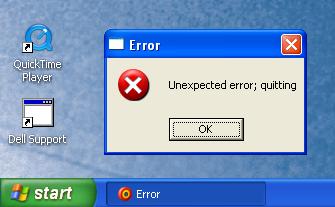
You will see the same error if you try to start Microsoft Antispyware manually,
if it has expired.
[/security/spyware/MS-Antispyware]
permanent link
Mon, Mar 06, 2006 11:58 pm
Copying Signatures from one PC to Another
Outlook signatures are stored at
C:\Documents and Settings\
username\Application Data\Microsoft\Signatures.
For each signature there will be an RTF, HTM, and .TXT file. To copy signatures
from one PC to another, simply copy the 3 files to the appropriate directory
on the second system.
[/network/email/clients/outlook]
permanent link
Mon, Mar 06, 2006 6:04 pm
ClamWin Outlook Integration Problem
A user was receiving an error message when she tried to send email
with attachments:
ClamWin
An Error occured reading clamscan report: [Errno 2] No such file or
directory:
u'c:\\docume~1\\beth\locals~1\\temp\\tmpafm-hj\\client_setup_wi
zard_err_jpg - Virus Deleted by ClamWin.txt
ClamWin 0.88 was installed on her system and integrated with Outlook so
that it was checking incoming and outgoing email for viruses. I had to
disable the Outlook integration to stop the error from occuring.
[
More Information ]
[/security/antivirus/clamav]
permanent link
Sun, Mar 05, 2006 11:59 pm
Installation of Advanced Registry Tracer (ART) with wpkg
I wanted to configure
wpkg for a silent
install of
Advanced Registry
Tracer (ART) from
Elcomsoft.
ART is a utility designed for analyzing changes made to the Windows Registry.
I couldn't find any information on the developer's site or elsewhere on
configuring it for a silent installation, so I looked at the setup.exe file with
FileAlyzer.
When I listed strings in the file, I saw "Nullsoft" and "NSIS", so I
knew it used the Nullsoft Scriptable Install System (NSIS).
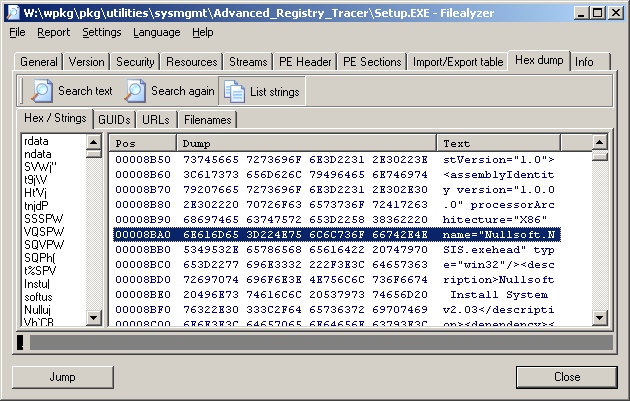
That installer normally allows you to perform a silent install
with the "/s" option and to specify the installation directory with the
"/D=dir" option. So I put the following lines in the
wpkg packages.xml file to install the software in
"C:\Program Files\Utilities\SysMgmt\ART"
<package
id="ART"
name="Advanced Registry Tracer"
revision="1"
reboot="false"
priority="1">
<check type="uninstall" condition="exists" path="Advanced Registry Tracer" />
<install cmd='\\server\wpkg\pkg\utilities\sysmgmt\advanced_registry_tracer\setup.exe
/S /D=%PROGRAMFILES%\Utilities\SysMgmt\ART'>
<exit code="0" />
</install>
<remove cmd='"%PROGRAMFILES%\Utilities\SysMgmt\ART\uninstall.exe" /S' />
</package>
References:
-
Unattended, A Windows deployment system: Unattended/Silent Installation
Switches for Windows Apps
[/os/windows/software/wpkg]
permanent link
Sun, Mar 05, 2006 10:53 am
BASH Variables
Some useful variables available in the
BASH shell.
- $$ = The PID number of the process executing the shell.
- $? = Exit status variable.
- $0 = The name of the command you used to call a program.
- $1 = The first argument on the command line.
- $2 = The second argument on the command line.
- $n = The nth argument on the command line.
- $* = All the arguments on the command line.
- $# The number of command line arguments.
Example:
#!/bin/bash
if [ $# -eq 0 ]
then
echo "Usage: $0 filename"
else
wc -l $1
fi
The script first checks for whether any argument has been entered on the
command line, i.e. whether $# equals zero. If no arguments are present
on the command line, the script prints a usage message. The $0 variable
holds the name of the script itself. If an argument is entered on the
command line, it is presumed to be a filename and the wc command is called
to count the number of lines in the file.
So, if the script is named "example", and is called without any options,
then the following output would be printed.
# ./example
Usage: ./example filename
If a filename is entered on the command line and that file has 21 lines in
it, the following would be printed.
# ./example sample.txt
21 sample.txt
References:
-
Linux Shell Programming
[/os/unix/bash]
permanent link
Fri, Mar 03, 2006 4:55 pm
Proxying the LPD Port with Balance
I have a Solaris 10 system that is connected to one network card in a
Solaris 7 system. A second network card in the Solaris 7 system connects
to the
LAN. The Solaris 10
system has no other network connectivity. Its web access is obtained through
a SOCKS proxy server running on the Solaris 7 system. I needed to be able
to print to an HP laserjet printer on the network, so I needed some way
to proxy connections to the Line Printer Daemon (LPD) port, TCP port 515,
on which the network printer is listening, through the Solaris 7
system. The
balance load
balancing and proxy program works well for such situations. In this
case I didn't need to use the load balancing features of the program,
just its proxying feature.
[ Solaris 10 ] <-----> [ Solaris 7 ] <-----> ( Network )
The network interface on the Solaris system that faces the Solaris 7
system has an IP address of 192.168.1.1. So on the Solaris system, I issued the
following command:
# balance -b 192.168.1.1 -f 515 laserjet.moonpoint.com:515
I needed to run the command as root, since I was using a
well known port,
i.e. a port between 0 and 1023. To set up a process to use a well known
port requires root privilege, since those are commonly used by server processes.
The -b option specifies the IP address on which the system
should listen for connections. In this case I want the Solaris 7 system
to only listen for connections on the network card facing the Solaris 10
system, i.e. on IP address 192.168.1.1. Otherwise, by default, it would listen
on all network interfaces in the system. Also, normally, balance will run in the
background, but in this case I chose to keep it in the foreground with
the -f option; normally I would not use that option. I then
specify the local port on the Solaris 7 system on which it should listen
for incoming connections. In this case the port for printing is the LPD
port, TCP port 515 (balance only handles TCP ports). I then specify the
system and port to which balance should route the data. I can specify
a host, such as laserjet.moonpoint.com, or its IP address, such as 10.0.0.8,
followed by a colon and the port number to be used on the destination system,
which is the HP LaserJet printer with a network card in it.
Other options for balance are shown below.
bash-2.03$ balance
balance 3.19
Copyright (c) 2000-2003,2004 by Inlab Software GmbH, Gruenwald, Germany.
All rights reserved.
usage:
balance [-b host] [-t sec] [-T sec] [-dfp] \
port [h1[:p1[:maxc1]] [!] [ ... hN[:pN[:maxcN]]]]
balance [-b host] -i [-d] port
balance [-b host] -c cmd [-d] port
-b host bind to specific host address on listen
-B host bind to specific host address for outgoing connections
-c cmd execute specified interactive command
-d debugging on
-f stay in foregound
-i interactive control
-H failover even if Hash Type is used
-p packetdump
-t sec specify connect timeout in seconds (default=5)
-T sec timeout (seconds) for select (0 => never) (default=0)
! separates channelgroups (declaring previous to be Round Robin)
% as !, but declaring previous group to be a Hash Type
example:
balance smtp mailhost1:smtp mailhost2:25 mailhost3
balance -i smtp
According to the developer, Balance successfully runs at least on
Linux(386), Linux(Itanium), FreeBSD, BSD/OS, Solaris, Cygwin, Mac-OS X, HP-UX and
many more. Since it runs under Cygwin, you should be able to
get it to work on a Microsoft Windows system using Cygwin. It
is free Open Source software released under the GPL license. It
is available from
http://www.inlab.de/balance.html or
here.
On the Solaris 10 system, I'm using the Java Desktop System. I
clicked on "Launch", "Preferences", "System Preferences", and then
"Add/Remove Printer". I put in the root password when prompted, since
I was logged in under a normal user account. When the Solaris Print
Manager opened, I clicked on "OK" to use the default and only value
of "files" for the "Naming Service". I then clicked on "Printer"
and "New Network Printer". I gave the printer a name of "laserjet" and
specified "192.168.1.1" for the "Printer Server" value and selected
"TCP" for the "Protocol" value.
References:
-
RFC 1179 - Line Printer Daemon Protocol
-
Print Server Port Numbers for Netcat
by Jeff Liebermann jeffl (@) comix.santa-cruz.ca.us
Version 1.04 05/17/00
-
Setting up Sun Solaris 2.6, 7, and 8 to print to Canon Networked Printers
using LPD
-
Port Numbers
[/os/unix/programs/network/proxy]
permanent link
Thu, Mar 02, 2006 10:50 pm
Creating a Personal Distribution List in Outlook 2003
I created instructions for someone to use to build
a mailing list from a subset of the individual's in her contact list,
but I haven't yet figured out how she can add addresses from the contact
lists of others in her office, which have been shared and so can be accessed
by selecting them from under "Other Contacts" or by "Open Shared Contacts", but
which don't seem to be accessible when adding members to the personal distribution
list.
[
More Info ]
[/network/email/clients/outlook]
permanent link
Wed, Mar 01, 2006 8:45 pm
Obtaining Information About the Windows XP Firewall from the Command Line
If you wish to check the state of the Microsoft Windows XP firewall software,
you can issue the following command from a command line prompt.
C:\Documents and Settings\Administrator>netsh firewall show state
Firewall status:
-------------------------------------------------------------------
Profile = Standard
Operational mode = Enable
Exception mode = Enable
Multicast/broadcast response mode = Enable
Notification mode = Enable
Group policy version = None
Remote admin mode = Disable
Ports currently open on all network interfaces:
Port Protocol Version Program
-------------------------------------------------------------------
10243 TCP IPv4 (null)
10280 UDP IPv4 (null)
10281 UDP IPv4 (null)
10282 UDP IPv4 (null)
10283 UDP IPv4 (null)
10284 UDP IPv4 (null)
20099 TCP IPv4 C:\Program Files\Network\SSH\OpenSSH\usr\sbin\sshd.exe
3389 TCP IPv4 (null)
42599 TCP IPv4 C:\Program Files\Network\pcAnywhere\awhost32.exe
42600 UDP IPv4 C:\Program Files\Network\pcAnywhere\awhost32.exe
2869 TCP IPv4 (null)
1900 UDP IPv4 C:\WINDOWS\system32\svchost.exe
The command also shows the open ports and applications that have opened
particular ports.
You can also request information just on open ports with netsh
firewall show portopening as below.
C:\Documents and Settings\Administrator>netsh firewall show portopening
Port configuration for Domain profile:
Port Protocol Mode Name
-------------------------------------------------------------------
10280 UDP Enable Windows Media Connect
10281 UDP Enable Windows Media Connect
10282 UDP Enable Windows Media Connect
10283 UDP Enable Windows Media Connect
10284 UDP Enable Windows Media Connect
10243 TCP Enable Windows Media Connect
1900 UDP Enable SSDP Component of UPnP Framework
2869 TCP Enable UPnP Framework over TCP
Port configuration for Standard profile:
Port Protocol Mode Name
-------------------------------------------------------------------
20099 TCP Enable SSH
10280 UDP Enable Windows Media Connect
10281 UDP Enable Windows Media Connect
10282 UDP Enable Windows Media Connect
10283 UDP Enable Windows Media Connect
10284 UDP Enable Windows Media Connect
10243 TCP Enable Windows Media Connect
1900 UDP Enable SSDP Component of UPnP Framework
2869 TCP Enable UPnP Framework over TCP
3389 TCP Enable Remote Desktop
You may notice that the second example doesn't list the two ports
opened by pcAnywhere, TCP port 42599 and UDP port 42600 (the system is
using non-standard pcAnywhere ports), which are listed in the first
example. That is because those ports were allowed to be open in the
firewall not by designating the specific ports as allowed, but by
specifying the program that opens them as an "allowed program". You
can see the allowed programs by using the command netsh firewall
show allowedprogram.
C:\Documents and Settings\Administrator>netsh firewall show allowedprogram
Allowed programs configuration for Domain profile:
Mode Name / Program
-------------------------------------------------------------------
Enable Remote Assistance / C:\WINDOWS\system32\sessmgr.exe
Allowed programs configuration for Standard profile:
Mode Name / Program
-------------------------------------------------------------------
Enable Remote Assistance / C:\WINDOWS\system32\sessmgr.exe
Enable pcAnywhere Main Executable / C:\Program Files\Network\pcAnywhere\Winaw32.exe
Enable pcAnywhere Host Service / C:\Program Files\Network\pcAnywhere\awhost32.exe
Enable pcAnywhere Remote Service / C:\Program Files\Network\pcAnywhere\awrem32.exe
Enable proxy / C:\Program Files\Network\Proxy\proxy.exe
In the above example, the AnalogX
Proxy program, proxy.exe, is allowed to open ports, though it was not running
at the time the command was issued and therefore hasn't opened any ports.
If you just want to know whether the firewall is enabled, you can use
the netsh firewall show service command.
C:\Documents and Settings\Administrator>netsh firewall show service
Service configuration for Domain profile:
Mode Customized Name
-------------------------------------------------------------------
Enable No UPnP Framework
Service configuration for Standard profile:
Mode Customized Name
-------------------------------------------------------------------
Enable No UPnP Framework
Enable No Remote Desktop
Other firewall "show" commands that are available are listed below.
C:\Documents and Settings\Administrator>netsh firewall show
The following commands are available:
Commands in this context:
show allowedprogram - Shows firewall allowed program configuration.
show config - Shows firewall configuration.
show currentprofile - Shows current firewall profile.
show icmpsetting - Shows firewall ICMP configuration.
show logging - Shows firewall logging configuration.
show multicastbroadcastresponse - Shows firewall multicast/broadcast response configuration.
show notifications - Shows firewall notification configuration.
show opmode - Shows firewall operational configuration.
show portopening - Shows firewall port configuration.
show service - Shows firewall service configuration.
show state - Shows current firewall state.
[/os/windows/xp/firewall]
permanent link

Privacy Policy
Contact









